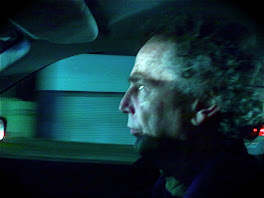It's never quite clear to me what is to be gained by going to look at houses where known people were born, grew up or at some stage lived, which doesn't mean I don't sometimes do it. At the very least, I suppose, there is subsequently a memory trace where before was either a blank or something imaginary. Which isn't to say the imaginary isn't preferable, only that it will in most cases recede before the real. Anyway ... having learned from Michael Ackland's book Damaged Men the addresses of the houses where James McAuley and Harold Stewart grew up, and realised they are both within a few kilometres of here, I went today to look at them.
52 The Crescent, Homebush, McAuley's home from the mid 1920s until he left home during WW2, is a small brick Victorian villa in a now leafy street running parallel to the main western line just down the road from the Homebush shops. It's shabby and neglected now, it looks like it's rented out, but it was probably far more prepossessing and indeed, straight-laced, when it belonged to the McAuley family. Jim's Dad was a successful real estate agent which raises the question as to why he kept on living in this rather small house in this rather grim suburb with its stockyards and its abbatoir; on the other hand, according to Jim, he was a rather grim man.
Although McAuley remembered the scent of wisteria, there's now a small frangi pani tree outside the window of the bedroom next to the front door, which may have been his: At night he watched the dancing shadows created by the lights of passing trains on his bedroom walls and dreamed of unknown destinations, Ackland says. The most startling presence in the street is an enormous Gallipoli Pine growing behind the house, one of the largest I have seen. McAuley, born in Lakemba in 1917, may have come into the world contemporaneous with this tree and I took its sombre presence as a sign that he still haunts the neighbourhood.
Chowringhee, where Harold Stewart was born in 1916 and where he grew up, is or was at 31 Tavistock Street, Drummoyne: a short, also leafy street, running up hill from Drummoyne Park with its green oval, not far from Five Dock Bay. All three streets crossing Tavistock are now major traffic arteries so the area does not have the quiet gentility it did when Harold lived here. His father, who was in India until his early thirties and spoke fluent Hindustani, was the local health officer.
The house at #31 presented the same drab exterior as did the McAuley residence, though it was clearly a much larger place. However, it seems to have been divided at some point into a makeshift duplex; the name plate, if there ever was one, has disappeared and I did wonder, since the other half of the duplex was #33, if I had the right house. Perhaps the street had been renumbered at some point?
This is what Ackland describes: Tavistock Street was shaded by camphor laurels and small gardens set off the entrances to most of its serried brick houses. The drab exterior of the Stewarts’ home accorded ill with its exotic Indian name ... and its tastefully presented interior. A large rear veranda afforded easy access to a modest oasis of calm, with fernery, fish pond, vines and a spreading apple tree, while Marion (Harold's sister, younger than him by nine years) remembered home-life as characterised by ahimsa, or non-violence of thought and deed.
There was a bullish looking man in a large 4WD parked outside #31 with the talkback radio turned up loud in his cab and he gave me the leery eye when I turned the car around and parked across the road to get a decent look at the house, so I didn't hang around for long. Ackland also writes: ... in the 1920s the future poet could still wander along dusty, unmade roads lined with gumtrees and post-and-rail fences, reminiscent of country towns, and shimmering water was always close at hand.
In contradistinction to the grimness of McAuley's bedroom (ordered and impersonal, its furnishings kept to a minimum with a bed, dresser and bare walls), Harold's served as study, art studio and music room ... the bed, which doubled as a settee when friends called, had a deep blue coverlet shot through with muted gold thread and [the room] contained a large desk, ample library, music stand and gramophone, as well as a small table for displaying art works — making it the prototype of his successive dwellings.
The strongest impression I took away from both houses is perhaps paradoxical: they each in their different way reminded me of the house at 40 Dalmer Street in Croyden, Ern Malley's sister Ethel's house, where the imaginary poet spent his last few imaginary months. This house was, as they say in fact, owned by Harold's sister, the aforementioned Marion ... the other thing I glimpsed, though only in passing, was the uniformity of these lower middle class western Sydney suburbs between the wars, with their rows and rows of near identical houses made of liver coloured brick, their pubs and corner shops, their bare streets where the trees, if they had even yet been planted, had scarcely begun to grow.
skip to main |
skip to sidebar
You are always at a nodal point where destiny forks ...
